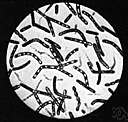The gut microbiota of breastfed babies was found to differ from those who were formula fed, with an increase in HMO-consuming bacteria from the families
Bacteroidaceae and Bifidobacteriaceae in breastfed infants (De Leoz et al., 2015).
Of the 71 families uniquely related to animal farming, the top five families were Bacillaceae,
Bacteroidaceae, Xanthomonadaceae, Streptococcaceae, and Lactobacillaceae (Table 4).
At family level, the gut microbiota was generally dominated by Clostridiales family XI Incertae sedis (mean relative abundance 21.8%, with representative genus Ezakiella and Finegoldia ), Enterococcaceae (16.6%, representative genus Enterococcus ), Prevotellaceae (15.2%, representative genus Prevotella ),
Bacteroidaceae (6.8%, representative genus Bacteroides ), and Enterobacteriaceae (3.8%, representative genus Escherichia/Shigella ).
A significant decrease in the abundance of Prevotellaceae was observed, while the abundance of
Bacteroidaceae and Rikenellaceae was significantly increased in the curcumin group [86].
The db-/db-AOE500 increased the relative abundance of Verrucomicrobiaceae by ninefold (P = 7.767E - 06, Q = 7.767E - 05), S24-7.33.3% (P = 0.00106, Q = 0.00533),
Bacteroidaceae 34.4% (P = 0.00158, Q = 0.00528), and Lactobacillaceae 127.2% (P = 0.01991, Q = 0.03983) and decreased the relative abundance of Rikenellaceae 47.8% (0.00106, Q = 0.00533) and Lachnospiraceae 20.6% (P = 0.02484, Q = 0.04141) (Figure 4(b)).
Within the three most dominant bacterial families, from the Firmicutes phylum and families Ruminococcaceae and Lachnospiraceae, there was a significantly greater similarity for MZ twins compared to dizygotic (DZ) twins, in contrast with the
Bacteroidaceae family, in which MZ and DZ twins had similar pairwise diversity.
Analyses of high-fat diet-induced ROR-[gamma]t-deficient and wild-type mice showed that the abundances of Porphyromonadaceae, Peptostreptococcaceae, Comamonadaceae, and
Bacteroidaceae were correlated with the expression of ileum IL17 cells and ROR-[gamma]t mRNA [35].
"Baby girls were more likely to have higher amounts of bacteria in the
Bacteroidaceae family, which are important for maintaining the mucus barrier that protects gut cells from damage by harmful substances," said Kozyrskyj.
 Bacteroidaceae - family of bacteria living usually in the alimentary canal or on mucous surfaces of warm-blooded animals; sometimes associated with acute infective processes
Bacteroidaceae - family of bacteria living usually in the alimentary canal or on mucous surfaces of warm-blooded animals; sometimes associated with acute infective processes